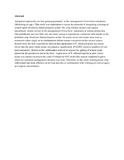| dc.description.abstract | Integrated approaches are fast gaining popularity
in the management of root knot nematodes
(
Meloidogyne
spp.). This study was undertaken
to assess the potential of integrating a biological
control agent (
Pochonia chlamydosporia
isolate
10), crop rotation (maize) and organic amendment
(maize stover) in the management of root knot
nematodes in tomato production. One greenhouse
and two field (dry and rainy seasons) experiments
were conducted with tomato as the preferred crop.
Pochonia chlamydosporia
isolate 10, maize stover
and maize were used as treatments either singly
or in combinations before tomato was grown in the
second season. Results from the field experiments
showed that application of
P. chlamydosporia
and maize stover into the plots where maize
was planted, significantly (
P<0.005
) reduced
numbers of root knot nematodes. Moreover the
combination reduced in season two galling of
tomato roots planted in the glasshouse and in the
field.. Application of
P. chlamydosporia
in plots
where maize was planted increased the yield of
tomato by 63% in the first season compared to
plots where no nematode management measure
was done. Therefore, in this study rotating maize
crop with tomato has been effective on its own and
also in combination with a biological control agent
and organic amendments. | en_US |

